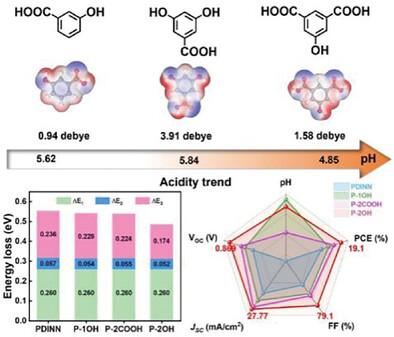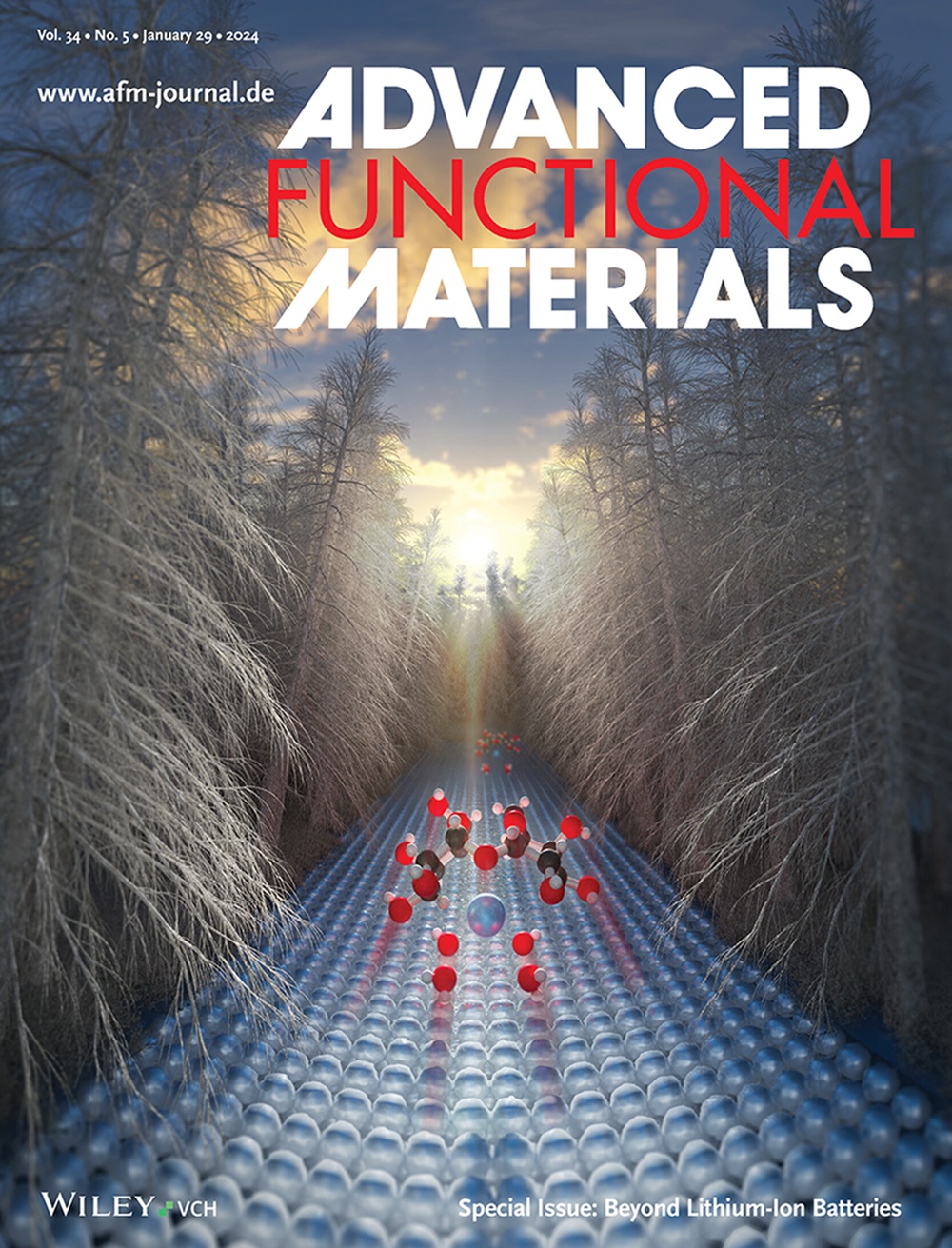推进有机光伏技术:过二亚胺电子传输层中偶极距离和酸度的作用
IF 18.5
1区 材料科学
Q1 CHEMISTRY, MULTIDISCIPLINARY
引用次数: 0
摘要
基于过二亚胺(PDI)的电子传输层(ETL)已被广泛用于高效有机太阳能电池(OSC)。然而,ETL 材料对界面陷阱和能量损失的影响仍未得到充分研究。本研究使用三种专门设计的、羧基和羟基含量不同的弱酸性材料,研究偶极距离对 PDINN 界面缺陷的影响。其中,3,5-二羟基苯甲酸(2OH)具有适中的 pH 值和较高的偶极距离,可增强与 PDINN 的分子间作用力。这种相互作用促进了 π-π 堆叠,增强了与活性层和银电极的欧姆接触。P-2OH 薄膜显示出更高更均匀的电位分布,抑制了界面上的电荷重组,将陷阱密度降低到 2.12 × 1016 cm3,并将非辐射损耗 ∆E3 从 0.236 eV 降低到 0.174 eV。因此,PM6: BTP-ec9/P-2OH 器件的能量损失从 0.553 meV 降至 0.484 meV。值得注意的是,P-2OH(10 nm)的功率转换效率(PCE)达到了 19.1%,当 P-2OH 厚度达到 50 nm 时,功率转换效率(PCE)仍然高达 16.4%,令人印象深刻。这项研究强调了羟基和羧基在调节 ETL 以尽量减少能量损失方面的重要性,并为开发对厚度不敏感的高性能 OSC 夹层提供了启示。本文章由计算机程序翻译,如有差异,请以英文原文为准。

Advancing Organic Photovoltaics: the Role of Dipole Distance and Acidity in Perylene-Diimide Electron Transport Layers
The electronic transport layer (ETL) based on perylene-diimide (PDI) has been widely demonstrated for efficient organic solar cells (OSCs). However, the effect of ETL materials on interfacial traps and energy losses remains understudied. This study investigates the effects of dipole distance on PDINN interface defects using three specifically designed weak acidic materials with varying carboxyl and hydroxyl group amounts. Among these, 3,5-dihydroxybenzoic acid (2OH), with moderate pH and high dipole distance, enhanced intermolecular forces with PDINN. This interaction boosted π–π stacking, enhanced ohmic contact with the active layer and Ag electrode. The P-2OH film exhibited a higher and more uniform potential distribution, suppressing charge recombination at the interface, reducing the trap density to 2.12 × 1016 cm3, and reducing the non-radiative loss ∆E3 from 0.236 to 0.174 eV. Consequently, the energy loss decreased from 0.553 to 0.484 meV for the PM6: BTP-ec9/P-2OH device. Notably, a decent PCE of 19.1% is achieved for P-2OH (10 nm), and it impressively remains a power conversion efficiency (PCE) of 16.4% when thickness of P-2OH up to 50 nm. This work underscores the importance of hydroxyl and carboxyl groups in regulating the ETL to minimize energy loss and offers insights for developing thickness-insensitive interlayers for high-performance OSCs.
求助全文
通过发布文献求助,成功后即可免费获取论文全文。
去求助
来源期刊

Advanced Functional Materials
工程技术-材料科学:综合
CiteScore
29.50
自引率
4.20%
发文量
2086
审稿时长
2.1 months
期刊介绍:
Firmly established as a top-tier materials science journal, Advanced Functional Materials reports breakthrough research in all aspects of materials science, including nanotechnology, chemistry, physics, and biology every week.
Advanced Functional Materials is known for its rapid and fair peer review, quality content, and high impact, making it the first choice of the international materials science community.
 求助内容:
求助内容: 应助结果提醒方式:
应助结果提醒方式:


